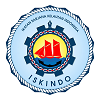Pengaruh Pemberian Lactobacillus sp. dengan Dosis yang Berbeda terhadap Sistem Imun Udang Vaname (Litopenaeus vannamei) yang diinfeksi Bakteri Vibrio parahaemolyticus
Abstract
Udang vaname merupakan udang hasil introduksi yang memiliki nilai ekonomis tinggi baik di pasar lokal maupun di pasar internasional. Salah satu penyakit yang sering menyerang udang vaname adalah Vibrio parahaemolyticus. Penelitian ini bertujuan untuk menguji pengaruh pemberian bakteri probiotik Lactobacillus sp. terhadaprespon imun udang vaname yang diinfeksikan dengan V. parahaemolyticus, Survival rate, dan kepadatan bakteri V. parahaemolyticus pada usus udang. Udang yang digunakan adalah udang yang berumur 62 hari yang dipelihara dalam akuarium berukuran 30x30x25 cm sebanyak 10 ekor. Penelitian dilakukan dengan 5 perlakuan yaitu Kontrol(–)(tanpa Lactobacillus sp. dan tidak diinfeksi), Kontrol(+) (tanpa Lactobacillus sp. kemudian diinfeksi), P1 (Lactobacillus sp. 106 CFU/ml), P2 (Lactobacillus sp. 108 CFU/ml), P3 (Lactobacillus sp. 1010 CFU/ml). Hasil penelitian menunjukkan bahwa pemberian Lactobacillus sp.dengan dosis 108 CFU/ml mampu meningkatkan THC udang vaname sebesar 5,58 x 106 sel/ml, sel hialin dan sel granular yang berperan penting dalam sistem imun udang, meningkatkan nilai SR udang sebesar 86,67% dan menekan pertumbuhan bakteri patogen V. parahaemolyticus. Berdasarkan hasil penelitian ini, penggunaan dosis probiotik Lactobacillus sp. yang dianjurkan pada budidaya udang vaname untuk meningkatkan sistem imun, tingkat kelangsungan hidup udang dan menekan pertumbuhan bakteri V. parahaemolyticus adalah 108 CFU/ml.
Kata kunci: Lactobacillus sp., V. parahaemolyticus, udang vaname, dosis Lactobacillus sp.
ABSTRACT
Vannamei is an introduced shrimp that has economic value in both local and international market. One of the diseases that often attack vannamei shrimp is Vibrio parahaemolyticus. This study aims to determine the probiotic bacteria Lactobacillus sp. against vannamei shrimp immune response infected with V. parahaemolyticus, Survival rate, and bacterial V. parahaemolyticus density of the shrimp intestine. Shrimp used are shrimp that is 62 days which is kept in aquarium size 30x30x25 cm as many as 10 shrimp. The study was conducted with 5 controls: Control (-) (without Lactobacillus sp. and not infected), Control (+) (without Lactobacillus sp. and infected), P1 (Lactobacillus sp. 106 CFU / ml), P2 (Lactobacillus sp. 108 CFU / ml), P3 (Lactobacillus sp. 1010 CFU / ml). The results showed that the administration of Lactobacillus sp. with a dose of 108 CFU / ml was able to increase THC vannamei shrimp by 5.58 x 106 cells / ml, hyaline cells and granular cells required in the shrimp immune system, increasing shrimp SR value by 86.67% and core growth of V. parahaemolyticus. Based on the results of this study is the use of probiotic Lactobacillus sp. which is recommended in the cultivation of vaname shrimp to improve the immune system, the level of shrimp survival and suppress the growth of bacteria V. parahaemolyticus is 108 CFU / ml.
Keywords: Lactobacillus sp., V. parahaemolyticus, vannamei, dose of Lactobacillus sp.
Full Text:
PDF (Bahasa Indonesia)References
Alapide-Tendancia E.V dan L.A. Dureza. (1997). Isolation of Vibrio spp. From Penaeus monodon (Fabricius) with Red Disease Syndrome. Aquaculture, 154(2) 107-114.
Amirullah. (2017). Pengaruh Pemberian Probiotik Organ Dalam pada Boiler. Skripsi. Makassar: Jurusan Ilmu Peternakan Fakultas Sains dan Teknologi Universitas Islam Negeri Alauddin Makassar.
Amrouche T., Y. Boutin, G. Prioult, I. Fliss. (2006). Effects of Bifidobacterial Cytoplasm, Cell Wall and Exopolysaccharide on Mouse Lymphocyte Proliferation and Cytokine Production. International Dairy Journal, 16(1),70–80.
Andrade A.J. (2011). Shrimp Immunological Reactions Against WSSV: Role of Haemocytes on WSSV Fate. Tesis. Faculty of Bioscience Engineering, Ghent University.
Asma N, Z.A. Muchlisin , I. Hasri. (2016). Pertumbuhan dan Kelangsungan Hidup Benih Ikan Peres (Osteochilus vittatus) pada Ransum Harian yang Berbeda. Jurnal Ilmiah Mahasiswa Kelautan dan Perikanan Unsyiah, 1(1), 1-11.
Araneda M, E.P. Perez, E.G. Leyva. (2008). White Shrimp Penaeus vannamei Culture in Freshwater at Three Densities: Condition State Based on Length and Weight. Aquaculture, 283, 13-18.
Badan Pusat Statistik. (2017). Ekspor Udang Menurut Negara Tujuan Utama 2000-2015.https://www.bps.go.id/LinkTabelStatis/view/id/1015 [21 April 2017].
Basir B. (2014). Kerja Probiotik Lactobacillus lactic dalam Saluran Pencernaan Udang Vanamei (Litopenaeus vannamei) dengan Pemberian Pakan yang disuplemen Probiotik Kacang Hijau. Jurnal Balik Diwa, 5(2).
Battistella S., P. Bonivento, G.A. Amirante. (2009). Hemocytes and Immunological Reactions in Crustaceans. Italian Journal of Zoology. ISSN: 1125-0003 (Print) 1748-5851 (Online). Journal homepage:http://www.tandfonline.com/loi/tizo20.
Briggs M, S.F. Smith, R. Subasinghe, M. Philips. (2004). Introductions and Movement of Penaeus vannamei and Penaeusstylirostris in Asia and the Pacific.Food and Agriculture Organization of the United Nations. Regional Office for Asiaand the Pacific. Bangkok. RAP Publication 2004/10. 12 pp.
Chiu C.H. Y.K. Guu, C.H. Liu. T.M. Pan. W. Cheng. (2007). Immune Responses and Gene Expression in White Shrimp, Litopenaeus Vannamei, Induced by Lactobacillus plantarum. Fish & Shellfish Immunology. 23, 364-377.
Das B.K dan S.N Sethi. (2009). Immune Functions in Crustaceans. Application of Molecular and Serological Tools in Fish Disease Diagnosis (CIFA). Orisaa. India.
Effendy S., R. Alexander,T. Akbar. (2004). Peningkatan hemosit benur udang windu Penaeus monodon (Fab.). Pasca perendaman ekstrak ragi roti Saccharomyces cerevisiae pada konsentrasi yang berbeda. J. Sains dan Teknologi, 14(2), 46-53.
Ekawati, A. W., Nursyam, H., Widjayanto, E., & Marsoedi, M. (2012). Diatomae Chaetoceros ceratosporum dalam Formula Pakan Meningkatkan Respon Imun Seluler Udang Windu (Penaeus monodon Fab.). The Journal of Experimental Life Science, 2(1), 20-28.
Eknath A.E., B.K. Mishra, B.K. Das, P. Swain. (2009). Aplication of Molecular and Serological Tools in Fish Disease Diagnosis. ICAR.
Febriani D. (2012). Kappa-Karagenan sebagai Imunostimulan untuk Pengendalan Penyakit Infectious Myonecrsis (IMNV) pada Udang Vaname, Litopenaeus vannamei. Skripsi. Bogor: Sekolah Pascasarjana, Institut Pertanian Bogor.
Feliatra, Zainuri, D. Yoswaty. (2012). Pathogenitas Bakteri Vibrio sp. Terhadap Udang Windu (Penaeus monodon). Jurnal Sungkai, 2(1), 23-36.
Fernando E. (2016). Pengaruh Variasi Dosis dan Frekuensi Pemberian Probiotik pada Pakan Terhadap Pertumbuhan Serta Mortalitas Udang Vaname (Litopenaeus vannamei). Skripsi. Surabaya: Fakultas Sains dan Teknologi Universitas Airlangga.
Gudding R., A. Lillehaug, O. Evensen. (2014). Fish Vaccination. Willey Blackwell. Amerika.
Haliman R.B dan D. Adijaya. (2008). Udang Vananamei. Jakarta: Penebar Swadaya.
Hauton, C. (2012). The scope of the crustacean immune system for disease control. Journal of invertebrate pathology, 110(2), 251-260.
Hatmanti, A. (2003). Penyakit Bakterial pada Budidaya Krustasea serta Cara Penanganannya. J. Oseana, 28(3), 1-10.
Indraswati V.O., S. Supono, A. Saefullah. (2015). Suplementasi Minyak IKan untuk Peningkatan Imunitas Non Spesifik Udang Vaname (Litopenaeus vannamei). Jurnal Ilmu Perikanan dan Sumberdaya Perairan, 3(2).
Jayasree L, P. Janakiram, R. Madhavi. (2006). Characterization of Vibrio spp. Associated with Diseased Shrimp from Culture Ponds of Andhra Pradesh (India). Journal of The World Aquaculture Society, 37(4), 523-532.
Kongnum, K., & Hongpattarakere, T. (2012). Effect of Lactobacillus plantarum isolated from digestive tract of wild shrimp on growth and survival of white shrimp (Litopenaeus vannamei) challenged with Vibrio harveyi. Fish & shellfish immunology, 32(1), 170-177.
Kurniawan L.A., M. Arief, A. Manan, D.D. Nindarwi. (2016). Pengaruh Pemberian Probiotik Berbeda pada Pakan Terhadap Retensi Protein dan Retensi Lemak Udang Vaname (Litopenaeus vannamei). Journal of Aquacuture and Fish Health, 6(1).
Lesmanawati W. (2013). Aplikasi Sinbiotik pada Udang Vaname Litopenaeus vannamei: Resistensi terhadap Infectious Mynocrosis Virus dan Performa Pertumbuhan. Tesis. Bogor: Program
Studi Ilmu Akuakultur. Fakultas Perikanan dan Ilmu Kelautan, Institut Pertanian Bogor.
Manoppo H. dan M. E.F. Kolopita. (2014). Respon Imun Krustase. Review Artikel, 2(22), 22-26.
Mulyadi A.E. (2011). Pengaruh Pemberian Probiotik pada Pakan Komersil terhadap Laju Pertumbuhan Benih Ikan Patin Siam (Pangasius hypopyhalmus). Skripsi. Jatinagor: Fakultas Perikanan dan Ilmu Kelautan Unpad.
Rahmanto S.P., Sarjito, D. Chimawati. (2014). Karakterisasi dan Uji Postulat Koch Bakteri Genus Vibrio yang berasal dari Media Kultur Massal Mikroalga. Journal f Aquaculture Management and Technology, 3(4), 230-237.
Sivakumar N., M. Sundararaman, G. Selvakumar. (2012). Probiotic Effect of Lactobacillus acidophilus Against Vibriosis in Juvenile Shrimp (Penaeus monodon). African Journal of Biotechnology, 11(91), 15811-15818.
Sivakumar N., G. Selvakumar, P. Varalakshmi, B. Ashokkumar. 2014. Lactobacillus sp. a Potent Probiotic for Disease Free Shrimp Aquaqulture. International Journal of Recent Scientific Research, 5(4), 1031-1045.
Smith, V. J., Brown, J. H., & Hauton, C. (2003). Immunostimulation in crustaceans: does it really protect against infection? Fish & Shellfish Immunology, 15(1), 71-90.
Soeharsono, L. A., Safitri, R., Sjofjan, O., Abdullah, S., Rostika, R., Lengkey, H. A., & Mushawwir, A. (2010). Probiotik Basis Ilmiah, Aplikasi, dan Aspek Praktis. Penerbit Widya Padjadjaran. Bandung.
Song Y.L dan C.Y. Li. (2014). Shrimp Immune System – Special Focus on Penaeidin. Journal of Marine Science and Technology, 22(1), 1-8.
Sunorita M. dan I. Tjarsono. (2014). Kebijakan Hambatan Non Tarif di Pasar Uni Eropa Terhadap Ekspor Komoditas Udang Indonesia. Jurnal Transnasional, 6(1).
Supramattaya K., J. Ruangsri, T. Itami, V. Chitiwan, W. Phromkunthong, K. Muroga. (2003). Morphology and Immunological Roles of Hemocytes and Fixed Phagocytes in Black Tige
Shrimp Penaeus monodon. Fish Pathology, 38 (2), 33-39.
Sritunyalucksana, K., & Söderhäll, K. (2000). The proPO and clotting system in crustaceans. Aquaculture, 191(1-3), 53-69.
Tjay T.H. dan K. Rahardja. (2007). Obat-Obta Penting Khasiat, Penggunaan, dan Efek-Efek Sampingnya. Jakarta: PT Elex Media Komputindo.
Verschuere L., G. Rombaut, P. Sorgeloos, W. Verstraete. (2000). Probiotics Bacteria as Biocontrol Agents in Aquaculture. App. Environ. Microbiol, 64, 655-671. S.
Vieira F.N., C.C. Buglione, J.P.L. Mourino, A. Jatoba, M.L. Martins, D.D. Schleder, E.R. Andreatta, M.A. Barraco, L.A. Vinatea. (2010). Effect of Probiotic Suplemented Diet on Marine Shrimp Survival After Challenge with Vibrio harveyi. Arquivo Brasileiro de Medicina Veterinaria e Zootecnia.On-line version.63 (3). ISSN: 1678-4162.Widanarni, Sukenda, M. Setiawati. 2008. Bakteri Probiotik dalam Budidaya Udang: Seleksi, Mekanisme Aksi, Karakterisasi, dan Aplikasinya Sebagai Agen Biokontrol. Jurnal Ilmu Pertanian Indonesia, 13(2), 80-89. ISSN: 0853-4217.
Widowati R. (2008). Keberadaan Bakteri Vibrio parahaemolitycus pada Udang yang dijual di Rumah Makan Kawasan Pantai Pangandaran.VIT VITALIS, 1(1).
Yennie Y. (2011). Isolasi dan Identifikasi Vibrio parahaemolitycus Patogenik pada Udang Tambak. Skripsi. Bogor: Sekolah Pascasarjana Institut Pertanian Bogor.
Yunita M., Y. Hendrawan, R. Yulianingsih. 2015. Analisis Kuantitatif Mikrobiologi pada Makanan Penerbangan (Aerofood ACS) Garuda Indonesia Berdasarkan TPC (Total Plate Count) dengan Metode Pour Plate. Jurnal Keteknikan Pertanian Tropis dan Biosistem, 3(3), 237-248.
DOI: https://doi.org/10.21107/jk.v11i2.3980
Refbacks
- There are currently no refbacks.

This work is licensed under a Creative Commons Attribution 4.0 International License.

Jurnal Kelautan by Program Studi Ilmu Kelautan is licensed under a Creative Commons Attribution 4.0 International License.
Published by: Department of Marine Sciences, Trunojoyo University of Madura













